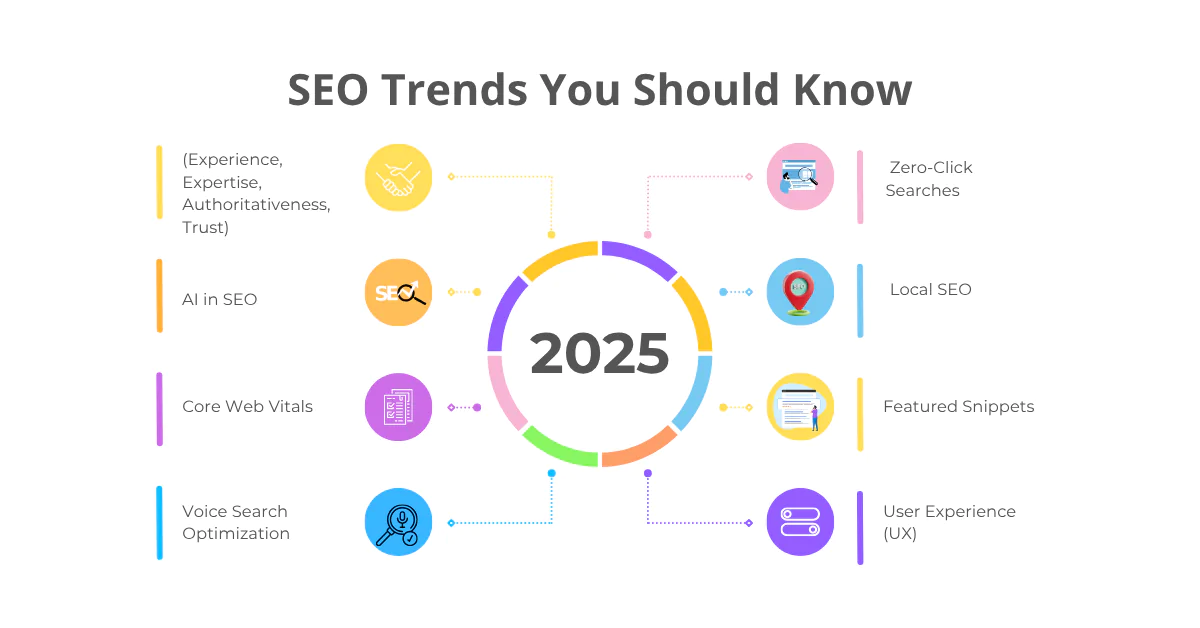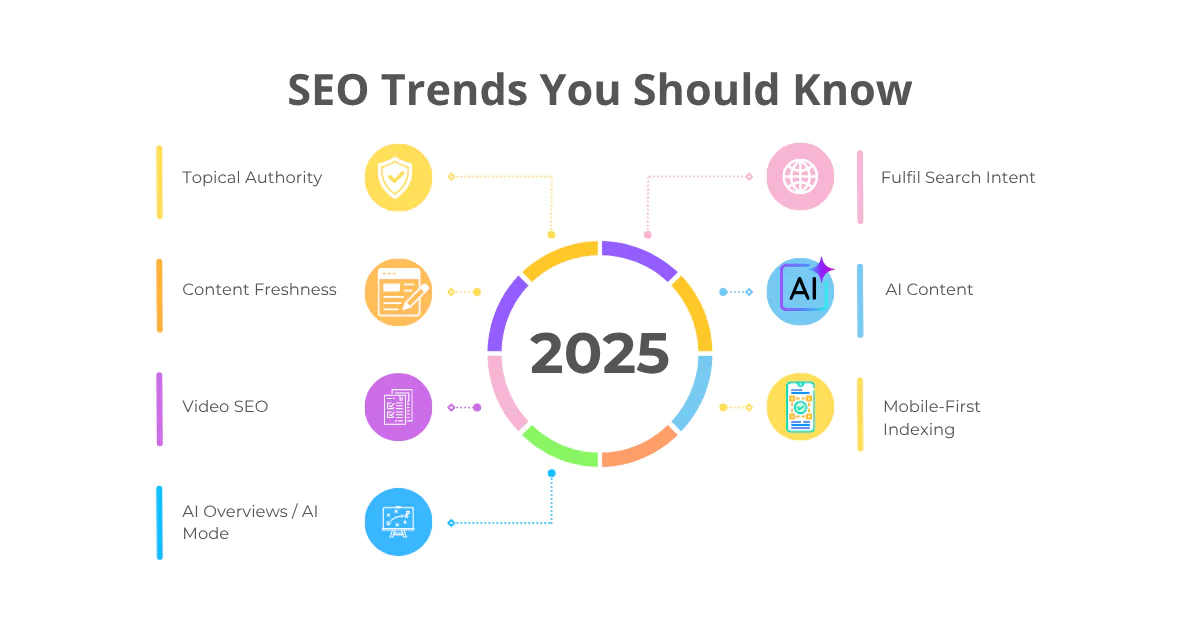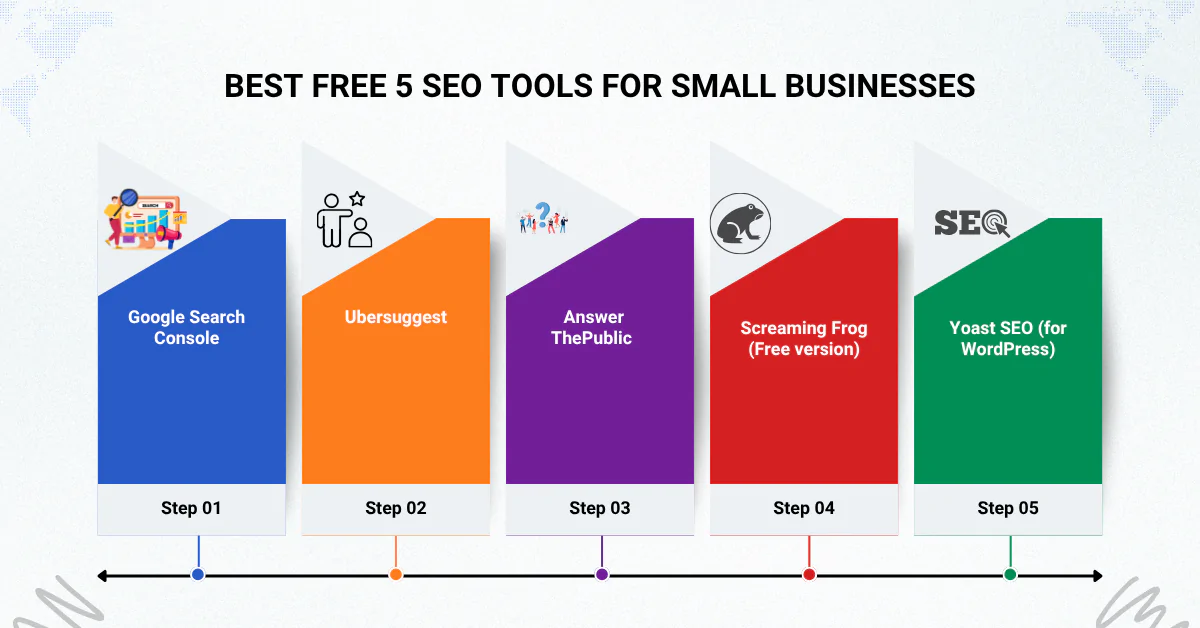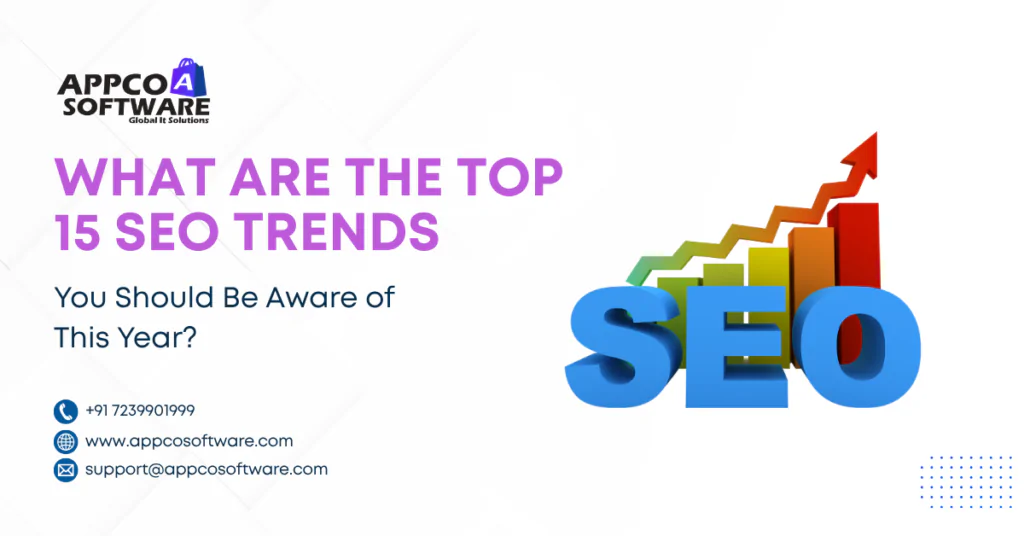Did you know that more than 93% of online experiences start with a search engine? And almost 70% of Google searches end without a single click on any website? This means we are getting answers directly from the Google overview. Today, you don’t even need to read the whole thing on a website, unless it’s really important.
Having said that, if you’re running a website in 2025 and want thousands of visitors to your website, you cannot rely on keywords anymore. In fact, you need to understand best SEO practices now. Not what worked five or ten years back.
This year, Google search engine optimization has moved far beyond just backlinks and content length. There’s AI, user signals, voice searches, and even visual content playing a big role.
What are SEO Trends?
SEO trends are the new ways people try to improve their rank on Google or other search sites. The old tricks don’t always work now because Google keeps changing how it shows results. A few years back, you just had to stuff the keywords in the content and you are good to go. But now, Google has changed its content policies. Now Google checks if the content delivered the real value to the user.
15 SEO Trends You Should Know in 2025

1. E-E-A-T (Experience, Expertise, Authoritativeness, Trust)
You might be thinking What does it mean by E-E-A-T, right? But the term (E-E-A-T) is Google’s way of checking if your content is useful. And if people can trust it. It’s not only about writing good articles. Google also checks who wrote it and how much real experience the writer does have. For example, if someone is running a Shopify store and writes about SEO for Shopify, Google will trust it more than a random person who has never done that work. Google, for example, looks at things like your name, your work details, your links, and what other websites say about you.
If you share useful content, examples, or your data, you will be more trustworthy. In simple words, Google wants useful content, written by someone who understands the industry. So, if you are giving Shopify SEO services and write regular blogs on it, make sure your name, work proof, and experience are clearly shown on the page.
2. AI in SEO
These days, AI is everywhere. From chat tools to writing helpers, everything is changing fast. But using AI in SEO doesn’t mean pressing one button and letting the robots do all your work. These tools surely can help with writing faster, finding keywords, or generating topic ideas. Tools like ChatGPT or Jasper are used by many SEO people now. But as a human, you have to verify, change, or improve the content to make it more useful.
Because you don’t want your blog to sound like a robot wrote it. Google is getting smart—it can often tell the difference. So, use AI for help, but add your real examples and thoughts to make the final content better. Also, if you don’t use AI at all, you may be slower than others. Others might write more and grow faster. So, it’s better to use both. AI plus your human creativity.
3. Core Web Vitals
Core Web Vitals may sound a bit techy. But it just means your website should open fast and run smoothly. Google now checks how your site works when people open it. Google checks three things: how fast the page opens, how soon people can click or read something, and whether the page shakes or jumps during loading. If your site is slow, people will close it. And that’s VERY bad for SEO.
You can even make small changes to make your website work faster. Things like reducing the image size, deleting extra plugins, or using an SEO-friendly theme on Shopify or WordPress. But if your site is fast and easy to use, people will stay longer. And Google likes that. In order to check the speed of your website, you can use several free tools such as PageSpeed Insights and Lighthouse.
4. Voice Search Optimization
Many people now talk to their phones to search for things. Like Hey, Google or Alexa type searches are growing fast. But voice search is not the same as typing. When people speak, they ask full questions like: which is the best SEO tool for a small business? So, your content should have full questions and easy answers too.
Yes, small keywords like Shopify SEO still help you, but voice search is more about how people talk in daily life. One good tip is to add an FAQ section on your page. It helps answer common questions clearly, and sometimes Google shows these in voice search results too. If your content works well with voice search, your site will show up more, especially on mobile. Voice search is growing, so it’s better to update now before it’s too late.
5. Zero-Click Searches
These days, many people type something on Google and get the answer right there on the same page. They don’t even open any websites. This type of result is called zero-click search. For example, if someone searches: What is SEO?, Google may show a small box with the answer taken from someone’s website. But the person may not visit that website. So even if it is your content, you may not get any visitors.
Still, it’s a good thing to be in that top box. It means Google is trusting your content. To reach that place, try to give short and easy answers, as if you are trying to help someone quickly. Use small headings, bullet points, and write in very simple English. You can also add common questions like how to improve Shopify SEO, or what is Google search engine optimization? If your content comes in that box, more people will see your brand name. Even if they don’t open your site, they may remember it. Later, when they need full help, they might come back to your website.
6. Local SEO
If your business is in one place, like Delhi, Mumbai, or Bangalore, then local SEO helps nearby people find you easily. For example, if someone types the best Shopify SEO company in Pune, Google will first show companies from Pune. So it’s very important to mention your city name and correct details online.
First, make a Google Business Profile. Put your full address, phone number, open hours, and some nice photos. Also, ask your happy customers to give reviews. These reviews help a lot with local search. Use local words in your writing, like Shopify SEO services in Hyderabad or SEO tips for small Delhi shops. This shows Google where your business is and who you are trying to help. If you don’t do local SEO, you may lose nearby customers who are ready to buy. So, it’s better to list your business, get reviews, and keep your online info always up to date.
7. Featured Snippets
That small box on top of Google search with a quick answer? That’s called a featured snippet. Getting your content there is kind of like winning big in SEO. For example, if someone searches how to do SEO for beginners? And your blog gives a clear and simple answer. Google might choose your content for that top box. That means more people will see your name, trust it more, and maybe even click.
To try for that spot, write your content in a clean and simple way. Use short lines, bullet points, and easy-to-read headings. Answer common questions in a very direct way. But don’t pack the page with too much text without breaks—Google usually skips that type. Still, not every topic gets a featured snippet. But you can try, especially for things like AI in SEO, Shopify SEO help, or Google search tips.
8. User Experience (UX)
User experience means how someone feels when they use your website. If the site is too hard to read or navigate, people will leave quickly. And when many people leave like that, Google also notices and might drop your position. But no need to make a very innovative site. Simple is better in most cases. Just keep the text big enough to read, buttons working properly, and the site should not take too long to open.
If you’re using Shopify or any other platform, try not to put too many popups or banners. That just makes it busy. Instead, use clear menus and simple links. That helps people stay longer and look around more. Google watches things like how fast people leave and how long they stay. If visitors are spending more time, it usually means they found something useful. So keep your site clean and easy. Don’t confuse people. A smooth and clear design is usually the best.

9. Topical Authority
This means showing Google that your website talks properly about one subject. So instead of writing just one blog on SEO, you write many blogs that cover different parts of the same topic.
For example, if your site is about Shopify SEO services, you can write about:
- How to rank a Shopify store
- Best tools for Shopify SEO
- Mistakes in Shopify SEO
- And similar topics
When you cover everything like this, Google starts to see your site as useful. But this takes time. You won’t get results in a few days. If you keep adding simple and helpful posts around one subject, your site can slowly move up in search. If your blogs are all mixed up and not linked to one main idea, Google may not understand what your site is about. So choose one topic, and write many connected blogs around it. The more useful your content is, the better your results.
10. Content Freshness
Google usually likes new or updated content. But that doesn’t mean you need to write new blogs daily. Fixing and updating your old content is just as useful. Let’s say you wrote a blog in 2024 about “Best SEO tools.” Now, in 2025, if someone else writes a fresh version, Google will likely show the newer one first.
So every few months, check your old blogs. Fix broken links, add better screenshots, remove old info, and rewrite a few lines if needed. This helps show Google that your content is still useful now. If you leave your old blogs untouched, they may slowly lose their place, even if they were doing well before. If your topic changes often, like AI writing tools or Shopify SEO updates, then staying current becomes more important. Fresh content keeps you in the results and builds trust with both Google and people.
11. Video SEO
These days, people don’t just read, they watch. Whether it’s YouTube, Instagram Reels, or even a small product demo, videos are everywhere. So if you’re still doing only blog posts or text-based content, you’re missing out. Now, video SEO is all about making sure your videos are easy to find, not just on YouTube but even on Google search. That said, it’s not just about uploading anything and waiting for views.
You have to title the video properly, add a clear description, put in good tags, and maybe even add subtitles. It helps both search engines and your viewers. If the video is short, informative, and answers common questions. It has a better chance of showing up in search. On the flip side, low-quality videos or long, boring ones might turn people off. So don’t overdo it. Keep it simple, clean, and direct. And if you already write blogs, just turn those into short videos. Works well for Shopify SEO tutorials or product guides.
12. AI Overviews / AI Mode
So this is something pretty new—Google has started showing AI-based summaries right on top of search results. They’re called AI Overviews, and they’re rolling out slowly across different regions. What it does is, instead of just showing links, Google uses AI to give a full summary pulled from multiple sites. Now, you may be wondering, how does your website fit into that?
Even though this summary is done by AI, it still takes info from real websites like yours. So if your writing is simple, helpful, and explains the topic clearly, there’s a good chance some part of it can show up. But if your content is not clear, it may get left out. Try to write in a way that gives direct answers, especially for common questions like how to do or what is. Right now, it’s still early to say how all this will fully work. But one thing is clear—Google is slowly moving in this direction. So, getting ready for this kind of AI-based content showing up in search might help your site get more attention later.
13. Fulfil Search Intent
This one’s super important. At the end of the day, SEO is not just about keywords or tools—it’s about helping someone find exactly what they’re looking for. If someone types the best free SEO tools, they don’t want a long theory lesson. They want a list. That said, many people still forget this and stuff their pages with unrelated info just to hit word count.
You have to think like what is the person trying to get from this search. And that is the search intent. So if the topic is SEO for beginners, keep it basic. If it’s how to speed up a Shopify site, give step-by-step solutions, not a long intro on what Shopify is. On the flip side, if you get this part wrong, you’ll see people bouncing quickly. And Google sees that as a bad sign. So just be straight, clear, and give people what they want to know.
14. AI Content
Everyone’s using AI now. Some love it, some are scared of it. And some just don’t know how to make it work properly. That said, AI content is not bad. The lazy use of it is. Yes, AI can help speed things up, like writing outlines, titles, even a draft blog. But if you just copy-paste and publish, it’s going to sound robotic. And people can tell the difference. Google can tell, too.
So the smartest way is to use AI to get started, but then rewrite in your own tone. Add real examples. Talk like how you’d explain to a friend. That’s how you make AI content good. For example, if you’re writing about Shopify SEO services, talk about what you’ve seen with real clients. What works, what doesn’t? Add screenshots, link to case studies—basically, make it feel human.
15. Mobile-First Indexing
Most of us are glued to our phones. Whether we’re Googling something, watching YouTube, or shopping online, it all happens on mobile. Google knows this, and now it checks the mobile version of your site first, not the desktop version. So if your website looks great on a laptop but is all jumbled up on a phone, that’s a problem. That said, fixing it isn’t as hard as it sounds.
Start by checking how your site looks on your phone. If there is something wrong, it’s time to make some changes. On platforms like Shopify, you usually have mobile-friendly themes, but still, test them. Sometimes apps or banners mess things up. On the flip side, if your site works smoothly on mobile, you’ll probably get better rankings, more clicks, and happier users. Google is watching how your mobile site performs. So you should not ignore it.
Best Free 5 SEO Tools for Small Businesses

When you’re running a small business, budgets are usually tight. But that doesn’t mean you can’t improve your website’s SEO. There are plenty of free tools out there that do a pretty good job, especially if you’re just starting or managing things on your own.
1. Google Search Console:
This one’s a must. It shows how your site is performing on Google, which keywords you’re ranking for, and what issues need fixing. It’s completely free and straight from Google.
2. Ubersuggest:
Made by Neil Patel, this tool gives you keyword ideas, content suggestions, and basic traffic info. You don’t get full features in the free version, but it’s good enough to start with.
3. AnswerThePublic:
It helps you find what people are asking about your topic. Just type a word like Shopify SEO and it shows common questions related to it.
4. Screaming Frog (Free version):
This tool scans your site and tells you about broken links, missing tags, duplicate pages, and more. It is really useful for technical checks.
5. Yoast SEO (for WordPress):
If your site runs on WordPress, this plugin helps you write better meta titles, slugs, and descriptions. Easy to use, even for beginners.
Final Thoughts
SEO is not something you do once and forget. But SEO is a constant thing. And with time, SEO methods have been changing. So it’s good to follow the latest SEO trends, if you want your website to stay easy to find. It doesn’t matter if you’re using Google search optimization for your blog or trying to grow your Shopify store with help from a Shopify SEO company; it’s better to follow what is working now.
These days, in 2025, things like AI tools, voice search, mobile-friendly design, and simple user experience are getting more important. But even small things, like making your site faster or updating old pages, can help you a lot in many ways. If you ignore these changes, your site may go down in search results. And if your page is not on top, people may not even see it. So take your time, choose a few tips from here, and slowly start using them.
FAQs
1. What are the SEO trends in 2025?
In 2025, SEO is changing. And AI is the main thing. Other than that, you can see user experience, and E-E-A-T, zero-click searches are increasing.
2. What is the 80/20 rule of SEO?
According to the Pareto Principle (or 80/20 rule), 20% of efforts drive 80% of results. As a result, emerging brands can set their SEO investments toward the most effective opportunities to scale organic traffic and revenue.
3. What is a zero-click search?
A zero click search is one that doesn’t send you to a third-party website from an organic search result on Google, Bing, or Yandex.
4. What is the future of SEO in 2030?
Search engine optimization in 2030 will be heavily influenced by AI, voice search, and user experience.
5. What does SERP stand for?
SERP stands for Search Engine Results Page. It’s the page that comes up when someone types a search query into a search engine like Google, Bing, or Yahoo.
6. What are the 4 pillars of SEO?
You should break your efforts down across the four pillars of SEO – technical SEO, on-page SEO, content, and off-page SEO.


One Reply to “What Are the Top 15 SEO Trends You Should Be Aware of This Year?”
Anonymous
Thank you for sharing your info. I truly appreciate your efforts
and I will be waiting for your further post thanks
once again.